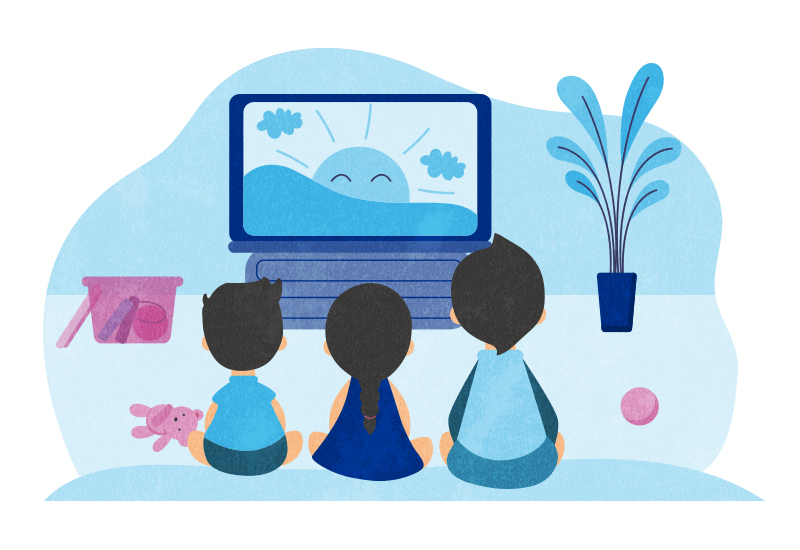Help your kids balance screen time and healthy play during COVID-19

Whether your child’s school is fully remote or hybrid this fall, chances are they’ll be spending extensive amounts of time in front of their computers. If, like many parents, you’re working from home, you may be relying more heavily on television and video games to keep your kids entertained. But how does all of this screen time affect developmentally stimulating activities, like playing or reading?
Exploring the relationship between screen time and play
The Center on Media and Child Health (CMCH) at Boston Children’s Hospital, in conjunction with Hasbro, Inc., recently studied the relationship between screen time and play in kids in Boston and Mexico City. The researchers also wanted to understand differences in cultural attitudes toward media time between the two countries.
While the data was collected before the COVID-19 pandemic, the findings are particularly relevant now, says David Bickham, the lead researcher at CMCH. He explains that while media use has become much more extensive over the past decade — and has possibly even increased more now with many schools going remote — not much attention has been paid to exploring the ramifications of this increased screen time on children’s overall development.
“We often hear there is a play deficit that has arisen specifically from screens and we wanted to see if this is true,” Bickham says. Since play is believed to have a significant role in development, especially in the first eight years of a child’s life, more time focusing on screens instead of playing can be a worrisome trade-off.
Tracking children’s habits
To learn more, Bickham and his colleagues followed the patterns of 198 children age 8 or younger living either in Boston or Mexico City.
“We asked parents to record the frequency of their child’s play on a daily basis in a diary, as well as the frequency of their child’s screen use each day,” he says.
The researchers hoped to meet two important goals with the information they collected. The first was to determine how much kids play each day. The second was to see if there was really a tradeoff between screen time and play.
Identifying cultural differences in media use and play
The study findings actually bring good news for families. They suggest that children do indeed play enough to fuel their early childhood developmental needs. But it’s important to note that time spent on screens does take away from time spent engaging in play, Bickham adds. This is something parents can pay attention to, and make an effort to encourage more play when possible.
Further, the findings reveal very different attitudes toward screen time and play between the U.S. and Mexico. While playtime, and to a lesser extent media use, dominate children’s leisure hours in both Boston and Mexico City, the way the activities play out is not the same in the two locations.
“In Mexico City, children invested more time in media use and chores, while in Boston, children spent more time outside and engaged in imaginative, object, physical, and board/card game play,” Bickham explains. He also points out that in Boston, the data suggest that the time spent using media replaces play, while in Mexico City, media use and play seem to reinforce each other more readily — the more time children in Mexico spent playing, the more time they also spent using media.
The differences between countries may be explained by cultural attitudes and nuances, he says.
The takeaway for parents
What this means is that on the days when children in Boston are playing more, they probably are watching less media. On the flip side, on days when children play less, parents can try to limit screen time and encourage more play to even out the equation. This is important, since regardless of where you live, getting enough play helps kids’ brains and bodies develop in an appropriate way.
To encourage your child to engage in healthy play, Bickham offers the following suggestions:
- Help your child transition from screen time to active play time. For instance, if your child is watching a cartoon, turn off the TV and encourage your child to build on the storyline themselves with toys.
- Carve out time specifically dedicated to play.
- Plan activities that incorporate different types of play, including board games, balls, blocks, and role play.
- Practice games using letters or numbers to help your child build important skills.
- Offer to play with your child and follow their lead on what they want to play.
- Give your child some toy and game options, but let them decide what they want to do.
- Encourage your child to be creative. They might turn meal time or bath time into a game.
- Provide simple household items like cardboard boxes, tissue paper, and egg crates and let your child design their own toys or games.
It’s okay if you feel overwhelmed right now and find yourself not encouraging your child to play as much as you would like. Many parents are struggling to work, teach their children, and keep up with housework. Be easy on yourself and remember every day isn’t going to be perfect. “The key is trying to help your child have balance,” says Bickham.
For more information, visit the Center for Media and Child Health, which offers a wealth of ideas and resources for parents to help kids play, and also follow #moreplaytoday.
Related Posts :
-

Five things to know before getting an online second opinion for your child
Whether you want to confirm your child’s diagnosis or treatment plan, another set of expert eyes can give you ...
-

Could the falcine sinus hold the key to vein of Galen outcomes?
A Boston Children’s Hospital study uncovers how fetal magnetic resonance imaging (MRI) could be a game-changer in predicting outcomes ...
-

Model enables study of age-specific responses to COVID mRNA vaccines in a dish
mRNA vaccines clearly saved lives during the COVID-19 pandemic, but several studies suggest that older people had a somewhat reduced ...
-

Keeping up with the tween skin care trend: What’s in those products?
More teens and tweens are hitting the mall to grab skin-care products they’ve seen on social media — but are ...





